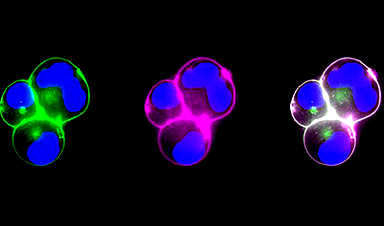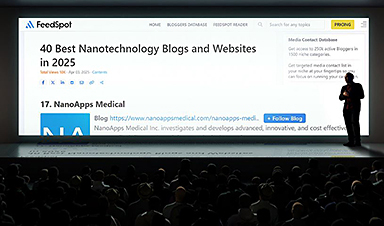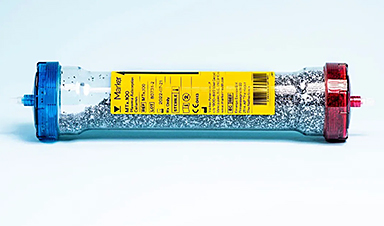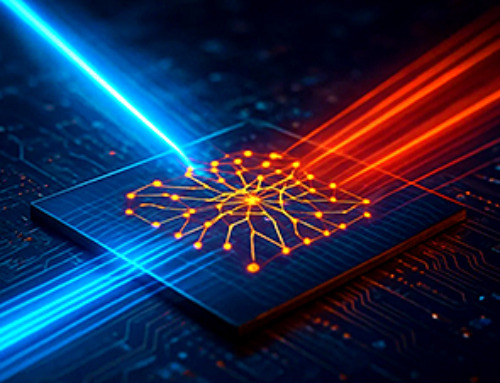Engineers at the University of California San Diego have developed modular nanoparticles that can be easily customized to target different biological entities such as tumors, viruses or toxins. The surface of the nanoparticles is engineered to host any biological molecules of choice, making it possible to tailor the nanoparticles for a wide array of applications, ranging from targeted drug delivery to neutralizing biological agents.
In the past, creating distinct nanoparticles for different biological targets required going through a different synthetic process from start to finish each time. But with this new technique, the same modular nanoparticle base can be easily modified to create a whole set of specialized nanoparticles.
“This is a plug and play platform technology that allows for rapid modification of a functional biological nanoparticle,” said Liangfang Zhang, a professor of nanoengineering at the UC San Diego Jacobs School of Engineering.
Zhang and his team detail their work in a paper, titled “A modular approach to enhancing cell membrane-coated nanoparticle functionality using genetic engineering,” published Oct. 30 in Nature Nanotechnology.
The modular nanoparticles consist of biodegradable polymer cores coated with genetically modified cell membranes. The key to their modular design is a pair of synthetic proteins, known as SpyCatcher and SpyTag, that are specifically designed to spontaneously—and exclusively—bind with each other. This pair is commonly used in biological research to combine various proteins.
In this study, Zhang and his team harnessed the pair to create a system for attaching proteins of interest to a nanoparticle surface with ease.
Here’s how it works: SpyCatcher is embedded onto the nanoparticle surface, while SpyTag is chemically linked to a protein of interest, such as one targeting tumors or viruses. When SpyTag-linked proteins come into contact with SpyCatcher-decorated nanoparticles, they readily bind to each other, enabling proteins of interest to be effortlessly attached to the nanoparticle surface.
For example, to target tumors, SpyTag can be linked to a protein designed to seek out tumor cells, and that SpyTag-linked protein is then attached to the nanoparticle. If the target shifts to a specific virus, the process is similarly straightforward: simply link SpyTag to a protein targeting the virus and attach it to the nanoparticle surface.
To create the modular nanoparticles, the researchers first genetically engineered human embryonic kidney (HEK) 293 cells—a commonly used cell line in biological research—to express SpyCatcher proteins on their surface. The cell membranes were then isolated, broken into smaller pieces, and coated onto biodegradable polymer nanoparticles.
These nanoparticles were subsequently mixed with SpyTag-linked proteins. In this study, the researchers used two different proteins: one targeting the epidermal growth factor receptor (EGFR) and the other targeting human epidermal growth factor receptor 2 (HER2), both of which are prevalent on the surface of various cancer cells.
As a proof of concept, the researchers tested these nanoparticles in mice with ovarian tumors. The nanoparticles were loaded with docetaxel, a chemotherapy medication, and administered to mice via intravenous injection every three days for a total of four injections. Treatment with these nanoparticles suppressed tumor growth while improving survival rate. Treated mice had median survival of 63 to 71 days, while the median survival of untreated mice was 24 to 29 days.
The researchers are looking to further improve the modular nanoparticle platform for targeted drug delivery.
In addition to cancer treatment, Zhang is excited about other potential applications of this technology. “Because we have a modular nanoparticle base, we can easily attach a neutralizing agent on the surface to neutralize viruses and biological toxins,” he said.
“There is also potential for creating vaccines by attaching an antigen on the nanoparticle surface using this modular platform. This opens the door to a variety of new therapeutic approaches.”
More information: A modular approach to enhancing cell membrane-coated nanoparticle functionality using genetic engineering, Nature Nanotechnology (2023). DOI: 10.1038/s41565-023-01533-w
Journal information: Nature Nanotechnology
News
5 Key Facts About Nanoplastics and How They Affect the Human Body
Nanoplastics are typically defined as plastic particles smaller than 1000 nanometers. These particles are increasingly being detected in human tissues: they can bypass biological barriers, accumulate in organs, and may influence health in ways [...]
Measles Is Back: Doctors Warn of Dangerous Surge Across the U.S.
Parents are encouraged to contact their pediatrician if their child has been exposed to measles or is showing symptoms. Pediatric infectious disease experts are emphasizing the critical importance of measles vaccination, as the highly [...]
AI at the Speed of Light: How Silicon Photonics Are Reinventing Hardware
A cutting-edge AI acceleration platform powered by light rather than electricity could revolutionize how AI is trained and deployed. Using photonic integrated circuits made from advanced III-V semiconductors, researchers have developed a system that vastly [...]
A Grain of Brain, 523 Million Synapses, Most Complicated Neuroscience Experiment Ever Attempted
A team of over 150 scientists has achieved what once seemed impossible: a complete wiring and activity map of a tiny section of a mammalian brain. This feat, part of the MICrONS Project, rivals [...]
The Secret “Radar” Bacteria Use To Outsmart Their Enemies
A chemical radar allows bacteria to sense and eliminate predators. Investigating how microorganisms communicate deepens our understanding of the complex ecological interactions that shape our environment is an area of key focus for the [...]
Psychologists explore ethical issues associated with human-AI relationships
It's becoming increasingly commonplace for people to develop intimate, long-term relationships with artificial intelligence (AI) technologies. At their extreme, people have "married" their AI companions in non-legally binding ceremonies, and at least two people [...]
When You Lose Weight, Where Does It Actually Go?
Most health professionals lack a clear understanding of how body fat is lost, often subscribing to misconceptions like fat converting to energy or muscle. The truth is, fat is actually broken down into carbon [...]
How Everyday Plastics Quietly Turn Into DNA-Damaging Nanoparticles
The same unique structure that makes plastic so versatile also makes it susceptible to breaking down into harmful micro- and nanoscale particles. The world is saturated with trillions of microscopic and nanoscopic plastic particles, some smaller [...]
AI Outperforms Physicians in Real-World Urgent Care Decisions, Study Finds
The study, conducted at the virtual urgent care clinic Cedars-Sinai Connect in LA, compared recommendations given in about 500 visits of adult patients with relatively common symptoms – respiratory, urinary, eye, vaginal and dental. [...]
Challenging the Big Bang: A Multi-Singularity Origin for the Universe
In a study published in the journal Classical and Quantum Gravity, Dr. Richard Lieu, a physics professor at The University of Alabama in Huntsville (UAH), which is a part of The University of Alabama System, suggests that [...]
New drug restores vision by regenerating retinal nerves
Vision is one of the most crucial human senses, yet over 300 million people worldwide are at risk of vision loss due to various retinal diseases. While recent advancements in retinal disease treatments have [...]
Shingles vaccine cuts dementia risk by 20%, new study shows
A shingles shot may do more than prevent rash — it could help shield the aging brain from dementia, according to a landmark study using real-world data from the UK. A routine vaccine could [...]
AI Predicts Sudden Cardiac Arrest Days Before It Strikes
AI can now predict deadly heart arrhythmias up to two weeks in advance, potentially transforming cardiac care. Artificial intelligence could play a key role in preventing many cases of sudden cardiac death, according to [...]
NanoApps Medical is a Top 20 Feedspot Nanotech Blog
There is an ocean of Nanotechnology news published every day. Feedspot saves us a lot of time and we recommend it. We have been using it since 2018. Feedspot is a freemium online RSS [...]
This Startup Says It Can Clean Your Blood of Microplastics
This is a non-exhaustive list of places microplastics have been found: Mount Everest, the Mariana Trench, Antarctic snow, clouds, plankton, turtles, whales, cattle, birds, tap water, beer, salt, human placentas, semen, breast milk, feces, testicles, [...]
New Blood Test Detects Alzheimer’s and Tracks Its Progression With 92% Accuracy
The new test could help identify which patients are most likely to benefit from new Alzheimer’s drugs. A newly developed blood test for Alzheimer’s disease not only helps confirm the presence of the condition but also [...]





















